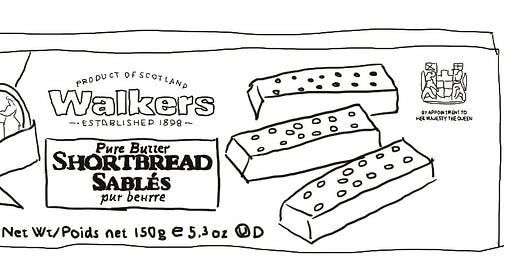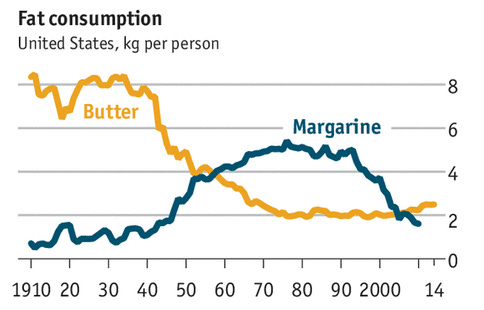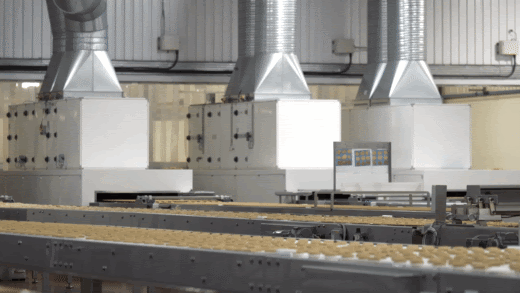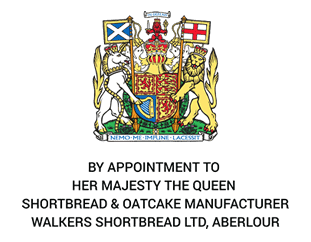Thanks to the 200+ subscribers who have joined this community! Keep the feedback coming! This week we’re kicking off the holiday season with deep dive on one of my favourite holiday treats 🤤.
I was hungry and confused.
How could there be only four simple ingredients?
A one-year shelf life?
A Royal Warrant from Queen Elizabeth on the label? On my local grocery store shelf, next to the house brand cookies, in a town of 5,000 people… 5,000km away from where they’ve been made in Scotland for over 120 years?
And only $3.79 a box? 👀
I had to buy some and figure out what was the story behind “The World’s Finest', Walker’s Shortbread.
Design
Shortbread is interesting to me because it evolved from the noble (and now trendy) idea of making the most of leftover food to avoid waste. Dating as far back as 12th century Europe, leftover bread dough would be dried out at a low temperature into a dry, hard “rusk” (twice-baked bread) and sometimes sprinkled with sugar to make a “bread biscuit”. Eventually the yeast in the dough was replaced with butter, which was referred to as the “short” or the added fat that resulted in a crumbly texture… hence the name shortbread. In the 1500s, Mary Queen of Scots was a big fan of the buttery treat and by the 1700s, Scottish cookbooks noted the first shortbread recipes with four basic ingredients: flour, sugar, butter, salt.
Armed with his mother’s shortbread recipe, 21 year old Joseph Walker opened his first village bakery in 1898 in Aberdeenshire, Scotland. Sticking with the same classic four ingredients for his shortbread, he developed a quality reputation and grew the business. Unfortunately the food rations imposed during the world wars limited the supplies of key ingredients like sugar and butter, but he kept his business afloat by making bread and rolls.
After the second world war, many bakers altered their shortbread recipes, dropping butter in favour of a cheaper alternative like margarine (the original plant based substitute!). However, the second generation, who were now running Walker’s bakery, remained committed to preserving their original recipe and kept butter in the recipe.
In the 1960s Joseph’s grandchildren joined the business and they pursued distribution beyond Aberdeenshire. First there was Harrods department store in London, then European and North American markets followed (including iconic Zabar’s deli in New York). Today the company employs over 1,200 people, produces +30,000 tonnes of products per year, sells into +100 countries around the world and generates ~£150 million in revenue . All while remaining family owned and managed (now by the fourth generation of Walkers) and produced in the same area of Scotland where it all began.
Innovation
The balance between tradition and innovation can be delicate for companies with deep histories. Over time, Walker’s has expanded their product line of cookie products (gluten free, novelty shapes, oat cakes, etc), but shortbread is still +75% of the business. By sticking to their long standing four ingredient recipe, the core of their business is focused on scaling and managing costs, instead of reformulating recipes. Even as they’ve grown the number of production facilities and output, their approach to process innovation has been measured as they’ve never wanted to lose any part of their classic taste or texture…. “Instead of mixing in bigger batches, we add more mixing machines.”
I thought a great example of their careful approach to change was when they recently announced a mild “brand refresh” of their packaging and logo. A core part of the update included adding a long absent apostrophe in their name, updating it from Walkers to Walker’s to “emphasize the company is still run by one family”. Not exactly an extreme makeover!
Sustainability
With its headquarters and primary production facilities still in the town of Aberlour, Scotland (population of ~1000), Walker’s has had an outsized impact on - and interdependence with - the community for over one hundred years. Just as management has been a family affair across generations, multiple generations of families have proudly worked for the company too.
Walker’s shortbread is made with no artificial colours, flavours or preservatives. The ingredients are not genetically modified (non-GMO) and are locally sourced when possible (including UK sugar and flour). The all important butter comes from free range grass-fed cows that are given no hormones or antibiotics. However, don’t be fooled, no matter how high the quality of the ingredients, shortbread is not to be confused with “healthy” and is best enjoyed in moderation or on special occasions! (more on this in the footnote)!
Unlike privately owned companies in Canada or the United States, private companies in the UK (like Walker’s) must report and submit their statement of accounts (financial statements) with the government, which are then made available for public review. I read through Walker’s 2019 statements and was surprised by the transparency and disclosure of their year in review, outlook for the business (including key risks and uncertainties). In particular, this stood out to me: “At the core of the company’s Mission and Vision Statement is the aim of being a ‘consistently profitable business that continuously invests in its people, brands, assets, processes and systems to ensure the continuity and security of the Walker’s brand and company in family ownership for generations to come’”. Or as Walker’s management was once quoted as saying, “We think in terms of generations, not quarters.”
The Walker’s website has a surprising amount of sustainability disclosure, including their integration of solar panels at their production facilities, packaging reduction efforts, waste recycling and water management. They’ve even proudly implemented a “toilet-flush reduction program”?! I was impressed to learn all of this but also found it surprising that none of this is communicated on the packaging. As third generation manager Jim Walker said in an interview (in a great Scottish brogue), “the whole success is down to integrity… we are what we say we are, and we don’t need a clever marketing man. We really are a 120 year old family company making the same simple product for 120 years… Corporate responsibility has been a buzz word for the past 5 or 10 years, but we’ve been doing it for a hundred years. We’ve always been looking after our people, but we’ve never said anything about it. It’s just a way to behave.”
Value
Walker’s shortbread exists at an intersection of craft, mass market, and affordable luxury. There aren’t many other products recognized with a royal warrant and available for under $5 on your local grocery store shelf. If you’re looking for even greater value, Walker’s has partnered with Costco and Kirkland brand to do a 2.1Kg tin for $28… now that’s VALUE! Given the mix of quality at an affordable price, it’s not surprising that the majority of the top 10 selling shortbread SKUs on Amazon.com are Walker’s brand.
Just as Jared wrote about with De Cecco dried pasta, by all means have a go at making your own shortbread at home or sourcing some locally from your favourite bakeshop. However, if time or budget does not allow, Walker’s Shortbread is a tough to beat treat.
-
Thanks again for reading this week! If you know anyone who is a fan of Walker’s or might have interest in reading these weekly stories, please share this newsletter with them.
As a reward for making it to the end, we offer your earbud’s this Walker’s Shortbread ASMR video 😳.
Footnote
As mentioned above, even with a simple ingredient list, and with no GMOs or artificial flavouring, colours or preservatives, shortbread is not to be mistaken as a “healthy” food. When I thought more about the combination of ingredients in shortbread, I was reminded of a 2013 book by Pulitzer Prize winning author Michael Moss, called: Salt, Sugar, Fat. How the Food Giants Hooked Us. It calls out these exact common ingredients as being “the three pillars of processed food”, that “override our dietary self-control” and are “so perfectly engineered to compel over consumption”. Perhaps a bit dramatic, but also pretty accurate. In recent decades, food manufacturers have increased the use of salt, sugar and fat to achieve a maximum “Bliss point”. It’s the sweet spot where it’s not too salty, sugary or rich in fats, but instead balanced in flavour, but most importantly the eater is rewarded with endorphins that encourage repeat consumption. Keep this in mind the next time you find yourself gorging on your favourite salty/sweet/rich treat!














Excellent topic! Walker’s Shortbread is always a treat. I particularly enjoy it when backpacking. It has an outstanding caloric content (butter ftw) and very little wasted airspace. I have calculated it’s caloric density at around 4900 calories/liter (just under almond butter, Larabars and Honey Stinger Waffles on my spreadsheet). This density along with shortbread’s durability means Walker’s Shortbread always earns a place in my bear can on backcountry trips!
Walker's is by far my favorite cookie. Thank you for writing about this topic!